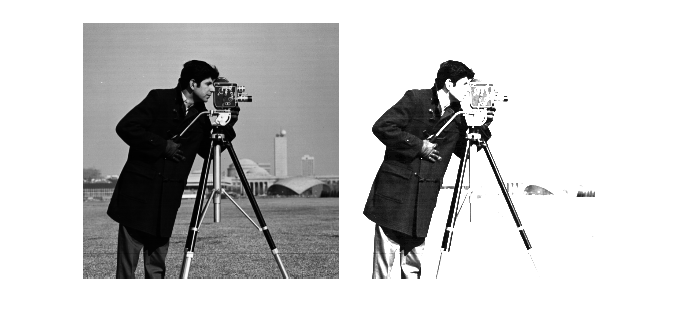Specify Contrast Adjustment Limits
You can optionally specify the range of the input values and the output values using
imadjust. You specify these ranges in two vectors that you pass to
imadjust as arguments. The first vector specifies the low- and
high-intensity values that you want to map. The second vector specifies the scale over which
you want to map them.
Note
You must specify the intensities as values between 0 and 1 regardless of the class of
I. If I is uint8, the values you
supply are multiplied by 255 to determine the actual values to use; if I
is uint16, the values are multiplied by 65535. To learn about an
alternative way to set these limits automatically, see Set Image Intensity Adjustment Limits Automatically.
Specify Contrast Adjustment Limits as Range
This example shows how to specify contrast adjustment limits as a range using the imadjust function. This example decreases the contrast of an image by narrowing the range of the data.
Read an image into the workspace.
I = imread('cameraman.tif');Adjust the contrast of the image, specifying the range of values used in the output image. In the example below, the man's coat is too dark to reveal any detail. imadjust maps the range [0,51] in the uint8 input image to [128,255] in the output image. This brightens the image considerably, and also widens the dynamic range of the dark portions of the original image, making it much easier to see the details in the coat. Note, however, that because all values above 51 in the original image are mapped to 255 (white) in the adjusted image, the adjusted image appears washed out.
J = imadjust(I,[0 0.2],[0.5 1]);
Display the original image and the contrast-adjusted image.
imshowpair(I,J,'montage')
Set Image Intensity Adjustment Limits Automatically
For a more convenient way to specify limits, use the stretchlim function. (The imadjust function uses
stretchlim for its simplest syntax,
imadjust(I).)
This function calculates the histogram of the image and determines the adjustment limits
automatically. The stretchlim function returns these values as
fractions in a vector that you can pass as the [low_in high_in] argument
to imadjust; for example:
I = imread("rice.png");
J = imadjust(I,stretchlim(I),[0 1]);By default, stretchlim uses the intensity values that represent the
bottom 1% (0.01) and the top 1% (0.99) of the range as the adjustment limits. By trimming
the extremes at both ends of the intensity range, stretchlim makes more
room in the adjusted dynamic range for the remaining intensities. But you can specify other
range limits as an argument to stretchlim.